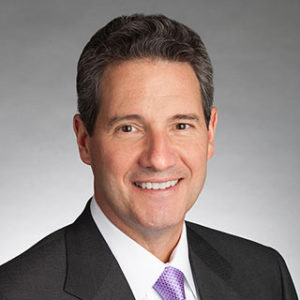Even after putting through 20 percent rate hikes over the course of this year, The Hartford needs another round of similar magnitude next year, the insurance company’s leader said recently.
The Hartford’s auto book won’t turn a profit until 2025, Chief Executive Officer Christopher Swift also reported during a session of the KBW Insurance Conference.
Swift, who signaled that his company would deliver 14-15 percent returns on equity both this year and next year, began his session with KBW Managing Director Meyer Shields, by highlighting the biggest positive contributors to The Hartford’s top and bottom lines—commercial insurance and group benefits. But personal lines is on a “self-help improvement schedule,” he said, referring mainly to the need to push rate into the personal auto line of business.
A longstanding marketing relationship that the carrier has with AARP will not cause the carrier to stray from a mission of returning personal auto results back to health, he stressed when Shield asked the CEO how his company balances its commitment to the AARP relationship with the need to respond to loss severity trends that carriers across the industry are facing. “I would tell you from a priority side, it’s not surprising that our sole focus is getting this book back to profitability—no matter what happens to PIF count [policies in force] or the top line. Obviously AARP will have a point of view. But contractually those are our decisions, and we’ll keep them posted on it. That’s what I would say on that.”

“We think we’ll have about 20 points of rate in the auto book by the fourth quarter, and continuing into ’24, we estimate that we probably will need another 15-20 points of rate in ’24 to be able to hit our targeted margins and ROE targets in 2025.”
Christopher Swift, The Hartford
Swift said that the underlying personal auto combined ratio for The Hartford will likely be nine points short of a targeted figure for 2023. (In February, guidance published by the company projected a personal auto underlying combined ratio in the 93-95 range, and an unadjusted combined ratio range of 100.5-102.5. Like other P/C carriers, The Hartford defines underlying combined ratio—a non-GAAP financial measure of underwriting results—as the combined ratio before catastrophes and prior year loss reserve development.) Through six months, The Hartford reported an underlying personal auto combined ratio of 108.5, excluding about 2.5 points of catastrophe losses and 2.4 points of prior-year unfavorable loss reserve development.
“It is still a long slog to get back to targeted profitability, which we estimate sometime in 2025,” Swift said. “The team knows what needs to be done. We’re working our filing programs, those that require prior approval and then using all our capabilities to file rates when needed in various states,” he said, later revealing that about 47 percent of Hartford’s premium volume is in states that require prior approval, while the other 53 percent are file and use or use and file sates. “So 50 percent of the book has a longer tail to get rate into it, and there’s a handful of states that are probably even longer than that,” he said, referencing West coast states, as well as Massachusetts and New Jersey on the East coast.
“We think we’ll have about 20 points of rate in the auto book by the fourth quarter, and continuing into ’24, we estimate that we probably will need another 15-20 points of rate in ’24 to be able to hit our targeted margins and ROE targets in 2025,” he said.
Shields asked if those rate hike forecasts assume “essentially stable severity trends.”
Swift said they do not. Instead, the indicated jumps assume that loss severity trends will “revert slightly,” he said—an assumption that Shields then agreed seemed reasonable since the Manheim index of used car prices, which carriers track, has been falling recently.
 As for how the AARP relationship factors into underwriting and rating actions, Swift explained that the insurer has had a 35-plus year relationship with AARP, helping The Hartford to garner some some insights into the mature market segment, “which generally means 60-plus” for the auto book, even though AARP has got strategies to try to be in the 50-to-60 age category as well.
As for how the AARP relationship factors into underwriting and rating actions, Swift explained that the insurer has had a 35-plus year relationship with AARP, helping The Hartford to garner some some insights into the mature market segment, “which generally means 60-plus” for the auto book, even though AARP has got strategies to try to be in the 50-to-60 age category as well.
“That relationship is one of an endorsed carrier relationship on an exclusive basis. So we’re the exclusive endorsed party for home and auto products nationally. In exchange for that endorsement, we pay in royalty fees based on premium volumes,” he said, describing this essentially as a commission. “That’s their role in the relationship….They have nothing to do with pricing. They have nothing to do with rate filings. They have nothing to do with claim settlements. They leave that up to us to manage—to their benefit though, if we can grow and have obviously good profitability.”
“That’s a major distinction [that] sometimes maybe people don’t understand. The underwriting, the growth, the investing strategies that we have are all ours. We keep [AARP] informed, but the nature of the relationship is ” one of co-marketing and positioning the AARP brand with our brand in that mature market segments,” he explained.
At other points in the session, Swift also addressed questions about other P/C lines of business in which The Hartford participates, spending some time discussing the company’s growing appetite in commercial property, trends in workers compensation and commercial automobile.
On commercial property, Shields asked Swift to talk about how he weighs worsening weather-related loss trends against efforts to grow in commercial property.
Swift noted that The Hartford has historically “been under indexed” in commercial property, with only 8 percent of premiums in the line on an annual basis. “What we’ve been working on very hard over really the last seven, six years is diversifying our product sets….If you really look at history, we just deemphasized property for the last 20 years, but starting five years ago we made the conscious decision to invest in more underwriting tools, better risk management and building out multi-peril models so that we can bring a broader-based property skillset to our distribution partners,” he confirmed.
That activity started before elevated levels of catastrophes started to impact the insurance industry but “as we sit here today, I feel very confident that we have the tools, the risk management capabilities, more importantly the talent on a national basis to make property more of a growth focus for us that is also then going to generate exceptional risk-adjusted returns in this environment,” Swift said.
He added, “You should not think of this as just a cat strategy. We’ll take on cat, but we really want fire perils on a national basis. So with that little market share, I think we could be very conscious in building…property capabilities…on a national basis that gets us a good spread of risk,” he said.
Swift described weighing the downside risks of growing a property book and the upsides of pricing and underwriting actions. “If it does come with a little tornado hail exposure. maybe a little wind, wildfire exposure and we think we’re getting the price” for taking on more cat and attritional losses, and the prospect of adjusting terms and conditions, attachment points, and sublimits on flood,” growing on the current schedule continues to make sense, he suggest. “Put it all together and we had about $2 billion of premium in 2022. We set a target to get to two-and-a-half this year. We’ll tell you what the target is for ’24 when we get there, but I think we’re growing nicely,” he said.





















 Good Times for U.S. P/C Insurers May Not Last; Auto Challenges Ahead
Good Times for U.S. P/C Insurers May Not Last; Auto Challenges Ahead  Is the AI Boom a Bubble Waiting to Pop? Here’s What History Says
Is the AI Boom a Bubble Waiting to Pop? Here’s What History Says  How Insurers Can Avoid Post-Merger Technology Failure
How Insurers Can Avoid Post-Merger Technology Failure  Artificial Intelligence Is Rewriting the Rules for Commercial Lines
Artificial Intelligence Is Rewriting the Rules for Commercial Lines 